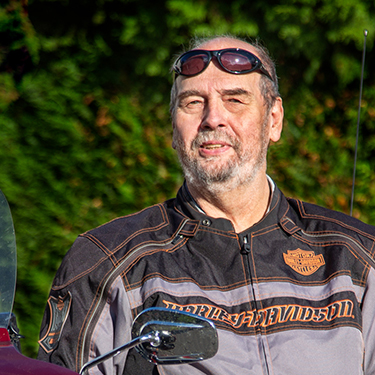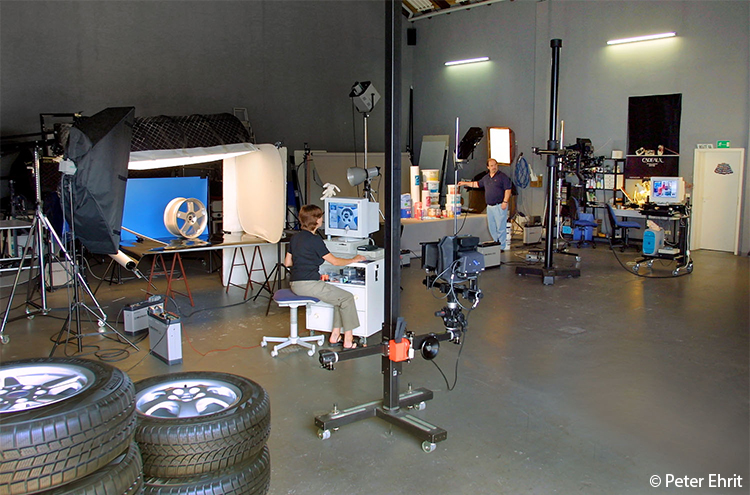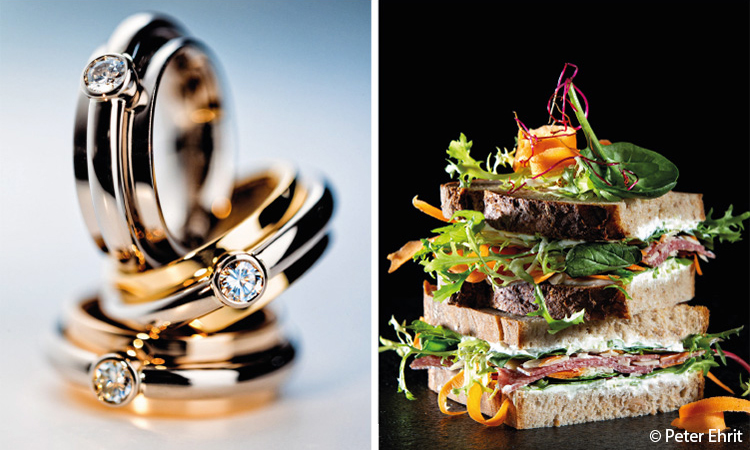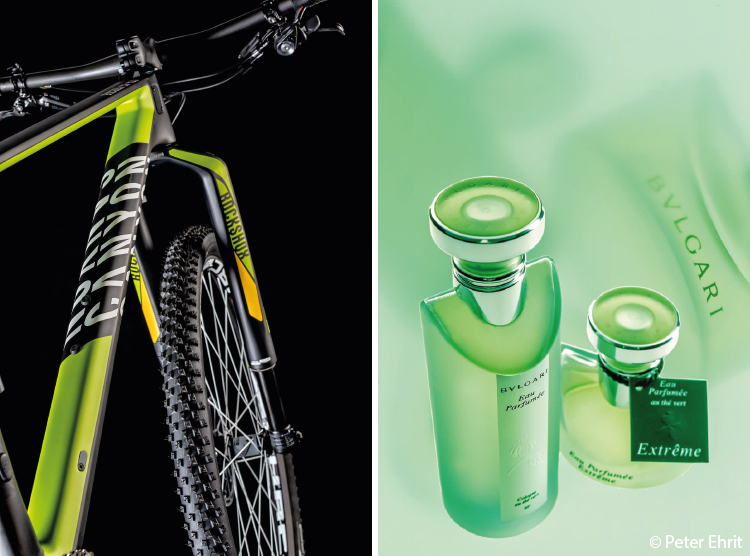Exclusive interview with Peter Ehrit
From traditional craft to digital post production: Peter Ehrit knows what he is talking about. He is an “old hand” in photography and one of the first customers of Bildretusche24. The advertising and product photographer is a pioneer in digital photography and was one of the first to experiment with body painting in the field of product photography.
 |
“To take a picture means painting with light. It was fascinating to experience the creation of the picture in the laboratory, which has now been completely lost due to digital photography.” |
We spoke in an exclusive interview with Peter Ehrit about his way into advertising and product photography, his most interesting projects and what it takes to be a good product photographer. As well as the change in photography and the importance of image processing today.
Peter Ehrit Werbefotografie GmbH in Mülheim-Kärlich.

Briefly asked
How does he prepare for a shooting? A successful shoot includes a good briefing in which the customer and photographer agree on the target group and imagery.
His favourite photographer?? Helmut Newton. Because he provokes in an excellent emotional composition.
His favourite camera? Starting with a Minolta, he now prefers to shoot with Canon and Phase One.
His most interesting project? The 1977 annual calendar for the company Boge Stoßdämpfe, which he implemented entirely on his own and in just seven days with two Playboy Playmates. Today one of the two is herself an excellent photographer in the international fashion world.
His opinion on CGI in photography? Ehrit is not a big fan of CGI, he thinks it is too emotionless and too clinically perfect.
Br24: How did you get into advertising and product photography and what are your specialities?
Peter Ehrit: I got my first camera when I was eight, an Agfa Box, which is how I discovered my love for photography. When I was 17 I had my first large-format camera, a SINAR Norma.
During my school days I was a freelance camera assistant at WRD in Cologne and discovered at that time that moving images were nothing for me, so I applied to the Folkwang School in Essen. I completed several semesters with Professor Dr. Otto Steinert. After that I had some internships at various photographers. Then I became the head of the photo studio of a large advertising agency in Cologne.
This was followed by two years of self-employment in Cologne, several years as a freelance photographer at Neckermann, Otto Versand, Foto Herr, Robert Pütz advertising agency. In 1977 I was offered the job of a studio manager in a large photo studio in Koblenz.
In 1978 I started my own business and since then have been working almost exclusively in advertising photography. My studio manager, Marion Lauenstein, and I mainly photographed high-quality jewellery, e.g. Goldschmiede Hofacker, Cadeaux, Christ, for prefabricated housing manufacturers such as Hufhaus, or cosmetics such as Douglas, Chopard, Lancaster, Bulgari. We worked a lot for the local advertising agencies in Koblenz and the surrounding area, thus a lot for PointS, Jack Wolfskin, various hardware stores, promotional products companies.
In 1991 we built our own photo studio in Mülheim-Kärlich. There we were able to expand our customer base, for example with Canyon Bicycles, in the food sector with Hack AG, Langnese, Shell deli2go, Kaufhof DINEA.
Today our specialities are in the area of food, cosmetics, jewellery, product photography in the technical and industrial sectors.

Can you remember one of your first projects in this area?
One of my first big projects was, for example, the implementation/visualization of a person made from fruit and vegetables. One of the most interesting projects was the visualization of an annual calendar for the company Boge Stoßdämpfer, completely under my own direction with two Playboy Playmates in 1977.
You have been working in the field of advertising and product photography for a long time, the photo studio Peter Ehrit has existed since 1978. What do you think is particularly important in this area? What do you have to bring along?
A prerequisite for a successful picture is that you can put yourself in the end customer’s shoes in order to implement his wishes in a sales-promoting way. This requires sophisticated photo skills and a high level of craftsmanship. The most important thing of all is the eye, which even the most modern camera cannot replace in order to achieve a well-designed image. “The image is not created in the camera, but in the head.”
Products are often photographed at home within one’s own four walls. What are the biggest differences between professional and self-made product photography?
Products photographed by the customer himself, some with smartphones, are unfortunately often good enough [editor’s note: for the customer]. The images of a professional, on the other hand, are significantly better to very good in the implementation in terms of design, light and technique. The professional photographer is a “creator with light” and, through the deliberate use of light direction and light character, achieves an image that becomes an “eye catcher” and remains in the consciousness.

Being present online has become more and more important over the last few years. Hardly anyone can afford not to present their own products and services online. Be it with their own website, on social media, at online marketplaces, etc. How has this trend affected product photography? Have the requirements changed in the meantime?
Due to the low resolution and fast pace in the online area, the demand for high quality has unfortunately decreased significantly, which is why many former typical photographer customers now take their photos on their own without any photographic experience in terms of lighting and design.
As a result, the requirements have changed to the extent that it is no longer quality, but often only price and speed that are important.
How important is the online area for product photography and does print still play a major role?
The requirements for product photography should be just as high for the online area as for the print area, because “it should be a feast for the eyes, too”. The print sector continues to decline, as printed catalogues or brochures take much longer to be available to the customer, not to mention the additional costs of printing, and most importantly, they cannot be updated at short notice.

You have been working with Bildretusche24 for a long time, since 2010, to be precise. In fact, you were one of our first customers, which of course makes us all the more pleased. How important is professional digital post production in product photography?
Basically, a photographer should master Photoshop and know what is possible with it to optimise the image. Post production is crucial in order to optimise perfect photos even further, since optical laws can be circumvented. By highlighting important details, removing product defects (no product is perfect), and, for example, by using “dodge and burn”, the eye can be drawn to the essentials.
Which edits or services are carried out most frequently or requested by the customer? Are there any differences depending on which products are involved?
Most often, clippings with a path or mask are requested from us in order to use the product in various ways. Cut out on white or coloured areas for a quick overview in the online and print area. In addition, the clipped products are often used in composings, for example in landscapes, virtual backgrounds, etc.
In car photography, it is almost impossible to optimally represent the vehicle in a single shot, which is why several 100 optimised detailed shots are made, which are then combined into an overall composition of the “perfect car”.
There are differences in post production depending on the product:
On the one hand, simple, technically precise optimisation for the sales application. In contrast to the use in marketing and advertising. Here, the image processing has to be optimised to promote sales, as described above.
There are products whose photographic implementation is very difficult and extremely complex. In these cases there is the option of renderings, which can show “inside and outside” at the same time, such as heating tanks, cross-sections, etc.
We often find these renderings far too unemotional and clinical.
A real good photo cannot be replaced by anything
- 2023
- January (1)
- 2022
- December (2)
- November (1)
- October (2)
- September (2)
- August (1)
- July (1)
- June (1)
- May (1)
- April (1)
- March (1)
- February (1)
- January (3)
- 2021
- December (2)
- November (1)
- October (3)
- September (2)
- August (1)
- July (3)
- June (1)
- May (2)
- April (1)
- March (1)
- February (2)
- January (4)
- 2020
- December (2)
- November (3)
- October (4)
- September (1)
- August (2)
- July (1)
- June (2)
- May (3)
- April (3)
- March (3)
- February (4)
- January (4)
- 2019
- December (1)
- November (2)
- October (5)
- September (1)
- August (3)
- July (2)
- June (2)
- May (3)
- April (2)
- March (3)
- February (2)
- January (4)
- 2018
- December (2)
- November (2)
- October (3)
- September (3)
- August (2)
- July (2)
- June (2)
- May (1)
- April (1)
- March (2)
- February (3)
- January (2)
- 2017
- December (2)
- November (2)
- October (1)
- September (1)
- August (1)
- July (1)
- June (1)
- May (1)
- April (1)
- March (1)
- February (1)
